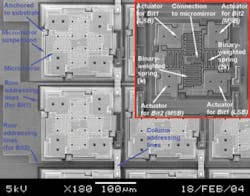Micromechanical digital-to-analog converter makes micromirror arrays more practical
Researchers at the National University of Singapore have found a way to simplify complex micromirror-array designs by using a mechanical rather than electrical digital-to-analog converter in the mirror controls. This new approach could yield smaller and less-expensive micromirror arrays, a critical component of the adaptive optics used in astronomy, biomedical imaging, free-space communications, and satellite imaging systems.
Large two-dimensional micromirror arrays are often desired in these applications; however, such arrays present several design, fabrication, and control challenges. In a conventional micromirror array, for example, the displacement of each mirror element is individually controlled by an electrical digital-to-analog converter. As a result, a large number of routing wires (and bonding pads, if off-chip control electronics are used) are required to connect each micromirror’s driving actuator to its corresponding electrical converter. There are two main disadvantages to this approach: several electrical digital-to-analog converters are required to individually control each micromirror in a large array, which increases the complexity and cost of the system; and the complexity of routing the driving signals for individual micromirror elements increases dramatically as the array increases in size, eventually limiting the total number of elements that can be used in the array.
According to Guangya Zhou, one of the researchers involved in this project, two fundamental mechanisms make the National University approach work (see figure). One is the micromechanical digital-to-analog converter mechanism, which allows the use of digital driving signals to control each micromirror element and eliminates any electrical DACs for analog displacement control, thereby simplifying the driving circuitry and reducing the overall system cost.
Traditional methods and approaches using high-precision positioners depend to a large extent on feedback control (closed loop) because of variations in manufacturing and operating conditions. This normally requires an ultra-high-precision position-sensitive detector and a sophisticated control module, which raises the complexity and cost of the overall system. A micromechanical digital-to-analog converter is driven by a set of digitally driven, open-loop, two-state (on/off) microactuators, which offers the advantages of low cost, simple driving electronics independent of driving-voltage noise and temperature fluctuations, high accuracy, and good repeatability. In addition, as a mechanical device, it is inherently robust and therefore suitable for harsh-environment applications in which conventional microelectronics might fail.
In the National University design, the proposed micromechanical digital-to-analog converter is driven by a set of two-state microactuators. The local displacement of each actuator is precisely determined by the gap spacing of the mechanical stops and is therefore independent of driving-voltage fluctuations. A set of connection springs is used to connect the microactuators to the output platform of the converter (in this case, it is a micromirror). The spring constants of these connection springs are carefully designed to be proportional to the binary weights of the corresponding input bits. As a result, the microactuator with the stiffest connection spring will have a most significant effect on the micromirror displacement (the microactuator is therefore referred to as MSB actuator). On the contrary, the microactuator with the most flexible connection spring will have the least significant effect on the micromirror displacement (the microactuator is therefore referred to as LSB actuator). In this way, the n-bit of local displacement accumulates in the suspension network to synthesize an analog output, which is proportional to the analog value coded with the n-bit input control word.
Line-addressing
The other key mechanism in the National University design is line-addressing, which is based on the hysteresis and bistable characteristics of the parallel-plate electrostatic driving actuators. This approach allows a large array of mirrors to be controlled via row and column addressing lines.
“In our device, the micromirrors and the upper electrodes of the driving actuators in a column are connected together by a column addressing line, while the lower electrodes corresponding to the same bit of the driving actuators in a row are connected by a row addressing line, thus drastically reducing the number of routing wires,” Zhou said.
To date, the researchers have built a prototype 2-bit, 3 × 3 micromirror array with 160 × 160-µm mirrors to demonstrate the digital-deflection characteristic and line-addressing capability. The mirror positions in the prototype are set to alter the phase of a 632.8-nm laser beam by one quarter of the wavelength, three-eighths of the wavelength, or leave it as is. The micromechanical digital-to-analog converter positions the prototype’s micromirrors precisely, with a range of 261 nm in increments of 87 nm.
The next step is to build a 4-bit digital-deflection micromirror array that contains 10 × 10 micromirrors. The ultimate goal is to produce a 6-bit device that contains more than 100 × 100 micromirrors, according to Zhou. Such an array could be used as a deformable mobile mirror for eliminating atmospheric blurring in astronomy and space surveillance applications, controlling the quality of communications laser beams, and correcting aberrations in retinal imaging. It also has the potential to be used as a programmable phase-only diffractive optical element or spatial light modulator for wavefront manipulation, such as in computer-controlled dynamic holographic optical tweezers.
This work, which is being funded by the National University, first appeared in the Nov. 15, 2004, issue of Optics Letters. Zhou’s colleagues on the project are Logeeswaran VJ, Fook Siong Chau, and Francis E. H. Tay.
About the Author
Kathy Kincade
Contributing Editor
Kathy Kincade is the founding editor of BioOptics World and a veteran reporter on optical technologies for biomedicine. She also served as the editor-in-chief of DrBicuspid.com, a web portal for dental professionals.
